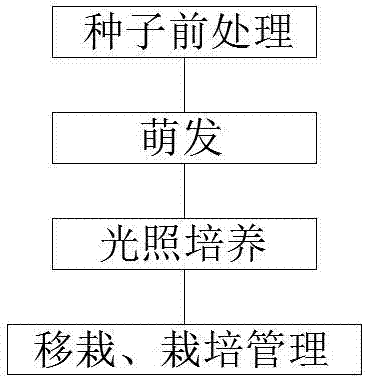Indoor quick cultivation method for wild peas
A technology of wild pea and cultivation method, applied in the field of wild pea cultivation, can solve the problems of low seed germination rate and survival rate, long cultivation time, etc., so as to improve the germination rate and survival rate, improve the germination rate, maintain absorption and air permeability Effect
- Summary
- Abstract
- Description
- Claims
- Application Information
AI Technical Summary
Problems solved by technology
Method used
Image
Examples
Embodiment 1
[0026] 1) Remove impurities from the vetch seeds, select 1,000 uniform seeds and treat them at -20°C for 24 hours, then wash them with water for 2 minutes, then soak them in 50 mg / L potassium permanganate for 8 minutes, and take out the soaked vetch seeds Obtain pre-treated vetch seeds;
[0027] 2) Rinse the pretreated vetch seeds obtained in step 1) with distilled water and spread them evenly on the seed rack of the seed germination box for germination. The nutrient solution in the germination box contains 5mmol / L NaCl and 10mmol / L mannitol , the nutrient solution was sterilized at 122°C and 0.1kPa for 20 minutes, and then cooled to room temperature before use. The germination conditions were 16 hours of natural light irradiation and 8 hours of dark environment alternately. Within 16 hours of natural light irradiation, the temperature in the seed germination box was kept at 18°C and relatively The humidity is 50%, and the temperature in the seed germination box is kept at 1...
Embodiment 2
[0032] 1) Remove impurities from the vetch seeds, select 1,000 uniform seeds and treat them at -10°C for 72 hours, then wash them with water for 3 minutes, then soak them in 150mg / L potassium permanganate for 10 minutes, and take out the soaked vetch seeds Obtain pre-treated vetch seeds;
[0033] 2) Rinse the pretreated vetch seeds obtained in step 1) with distilled water and spread them evenly on the seed rack of the seed germination box for germination. The nutrient solution in the germination box contains 20mmol / L NaCl and 20mmol / L mannitol , the nutrient solution was sterilized at 122°C and 0.1kPa for 20 minutes, and then cooled to room temperature before use. The germination conditions were 16 hours of natural light irradiation and 8 hours of dark environment alternately. Within 16 hours of natural light irradiation, the temperature in the seed germination box was kept at 25°C and relatively The humidity is 70%, and the temperature in the seed germination box is kept at 1...
Embodiment 3
[0038] 1) Remove impurities from the vetch seeds, select 1,000 uniform seeds and treat them at -15°C for 48 hours, then wash them with water for 2.5 minutes, then soak them in 100 mg / L potassium permanganate for 9 minutes, and soak the vetch seeds Take out and obtain the pre-treated vetch seeds;
[0039] 2) Rinse the pretreated vetch seeds obtained in step 1) with distilled water and spread them evenly on the seed rack of the seed germination box for germination. The nutrient solution in the germination box contains 12mmol / L NaCl and 15mmol / L mannitol , the nutrient solution was sterilized at 122°C and 0.1kPa for 20 minutes, and then cooled to room temperature before use. The germination conditions were 16 hours of natural light irradiation and 8 hours of dark environment alternately. Within 16 hours of natural light irradiation, the temperature in the seed germination box was kept at 22°C, relatively The humidity is 60%, and the temperature in the seed germination box is kept...
PUM
 Login to View More
Login to View More Abstract
Description
Claims
Application Information
 Login to View More
Login to View More - R&D
- Intellectual Property
- Life Sciences
- Materials
- Tech Scout
- Unparalleled Data Quality
- Higher Quality Content
- 60% Fewer Hallucinations
Browse by: Latest US Patents, China's latest patents, Technical Efficacy Thesaurus, Application Domain, Technology Topic, Popular Technical Reports.
© 2025 PatSnap. All rights reserved.Legal|Privacy policy|Modern Slavery Act Transparency Statement|Sitemap|About US| Contact US: help@patsnap.com

